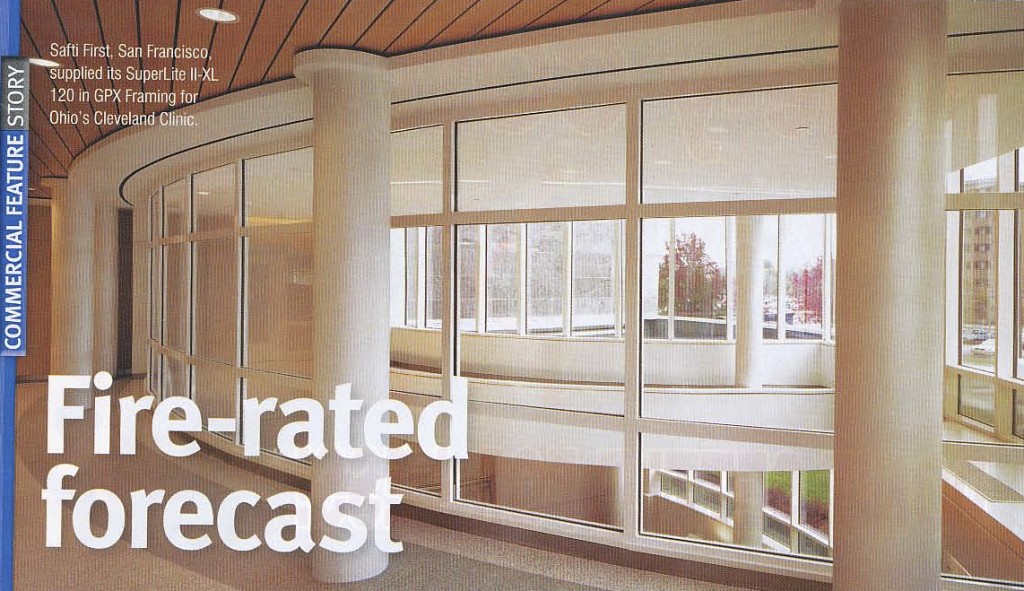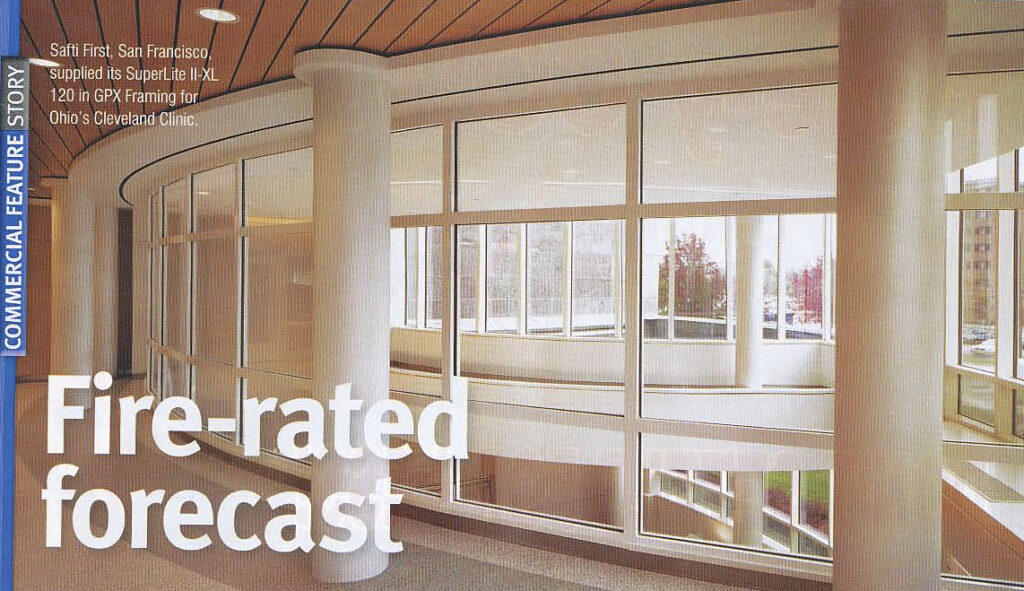Fire Rated Forecast

Fire Rated Forecast
Fire Rated Forecast first appeared in US Glass Magazine in Feburary 2010. It provides a look ahead a sales, market and product expectations in fire rated glass and framing.
Fire Rated Forecast: A look ahead at sales, market and product expectations
by Katy Devlin
 |
Nonresidential construction spending is expected to fall 5 percent in 2010, following a 5.7 percent loss in 2009, and isn’t expected to rebound until 2011, according to Jim Haughey, chief economist, Reed Construction Data, Norcross, Ga. Despite the grim forecast, representatives from fire-rated glazing suppliers remain optimistic. The market segment is partly insulated from the downturn thanks to code requirements, building trends and increased funding for some public projects, they say.
“Although we are currently experiencing a very soft market in the commercial construction industry, demand for non-wired fire-rated glazing products continues to grow,” says Dan Poling, sales manager, fire rated glass products, Schott North America Inc., Elmsford, N.Y. Poling attributes the growth to adoption of International Building Codes nationwide.
Jeff Griffiths, director of business development, Safti First, San Francisco, says the company saw growth across its entire product line in 2009 and anticipates continued growth in 2010. “We really can’t say for certain whether our success in 2009 resulted from an insulated market segment or continued expansion of market share, but we’re quite pleased with our bottom line and feel optimistic,” he says.
Christian Mueller, general manager, Vetrotech Saint-Gobain North America Inc., Auburn, Wash., says code requirements and increased code enforcement, education and government stimulus will drive fire-rated glass sales in 2010. “We expect the fire-rated glass segment to stay at current levels, since the government stimulus money is expected to translate into projects starts and to be spent in institutional areas in 2010,” Mueller said. “Also, code requirements and enforcement, along with increasing education about available fire-rated glass systems and its proper application at all levels of involved building professionals, will contribute to stabilize this segment.”
Jeff Razwick, vice president, business development, Technical Glass Products, Snoqualmie, Wash., says he’s more cautiously optimistic. “From a historic standpoint, [the fire-rated] market is typically more resilient than others since fire-rated is required by code in many buildings, particularly healthcare and educational facilities. But, we can’t ignore the fact that the dip in commercial construction is going to lead to fewer installations overall. Even with governmental funding for facilities that require fire-rated glass, this segment of the glazing industry is likely to face challenges.”
Strong segments
Traditional market segments for fire-rated glass—schools, healthcare facilities, government buildings—will remain the primary users in 2010, according to officials from fire-rated glazing suppliers. Interest is growing in fire-rated glass for commercial and industrial building types; however, that interest won’t translate into sales and installations until nonresidential construction begins to improve in 2011, officials say.
“Due to design requirements, we are seeing a growth in all sectors of the building industry, including residential and commercial,” Poling says. However, “due to the current economic environment, we anticipate the majority of demand in 2010 will be for educational and institutional projects.”
Mueller agrees. “Commercial and industrial projects will stay very limited until the economic climate will change and grow in 2011,” he says.
Suppliers should also look beyond new building. In both the institutional and commercial segments, renovation could offer opportunities for the fire-rated market, Griffiths says. “Adapting or expanding interior spaces within older buildings often includes upgrades related to new code requirements or contemporary design strategies that make use of modern fire-rated glazing systems,” he says. “Renovation is a market segment with significant potential.”
Market trends
“The fire-rated market is constantly evolving, and manufacturers must continue to adapt with new product and system solutions. The current economic downturn hasn’t changed that. If anything, it has served to speed up the innovation cycle as manufacturers seek to set themselves apart,” Razwick says. “At TGP … we look at where the market is heading—towards energy efficiency, sustainability and increased performance—and assess how our fire-rated products can also meet those goals.”
Trends in fire-rated glass are dictated by overall building trends, such as energy efficiency, as well as demands from the architectural community and building codes. New restrictions on wired glass (see sidebar), for example, combined with architect demands for improved aesthetics and increased daylighting force suppliers to continually update product offerings.
The green building movement has had a major impact on fire-rated glazing. Suppliers are coming out with more environmentally friendly fire-rated products, and designers are specifying fire-rated products in locations that will improve building efficiency.
“We see the green aspect of building products being an influential force in building design,” Poling says. “In regards to fire-rated glazing, we are able to offer eco-friendly products that do not contain arsenic, antimony or barium. This allows designers to open up a structure, allowing more natural light and views without detracting with bulky frames or unwanted tints.”
Griffiths adds, “with the added emphasis on energy efficiency, we’re seeing greater use of interior glazing as a design strategy to expand the use of daylight and minimize the use of artificial lighting. We’re especially seeing this in school projects at all levels. Fire-rated glazing in corridors, enclosed stairways and various types of interior spaces contributes to a sense of openness and enhances personal safety,” he says.
Fire-rated wall or partition systems and fire-rated systems for larger openings are also in demand, Mueller says. “Fire-rated curtain wall applications will give architects more flexibility to open up interior and exterior spaces, and to expand glazed areas, without compromising the fire-rating requirements of the building,” he says.
Architects are also seeking more sophisticated fire-rated designs, Razwick says. “The trend is toward sleek frame profiles, crisper sightlines and clearer views—and it seems to be growing in conjunction with code adoption,” he says. “Different types of buildings now have to meet specific fire ratings, and whether it’s 60 minutes, 90 minutes or 3 hours, architects want fire-rated applications to seamlessly blend with non-fire-rated applications,” he says.
This has also led to the emergence of more niche applications, such as fire-rated glass floors and decorative fire-rated products. “These applications are important because they show the industry that fire-rated glass is more than just functional,” Razwick says. “For instance, fire-rated glazed floors allow architects to meet codes while capturing light in a unique way. Up until recently, this was something they couldn’t do.”
Safti First has developed some decorative pattern options, and is working with some vendors to provide artwork within fire-rated assemblies on several projects, Griffiths says.
Architects and building owners are also looking to maximize the functionality of fire-rated glass, combining it with security and impact products. Mueller says interest is growing to use fire and security glazing for government facilities. “Fire-rated glass in combination with blast-resistant glass fulfills multiple safety and security code requirements. [Safety] has usually been compromised in the past,” he says.
Source: US Glass Magazine, February 2010